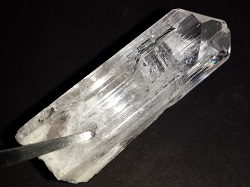A- |
B- |
C- |
D- |
E- |
F- |
G- |
H- |
I- |
J- |
K- |
L- |
M- |
N- |
O- |
P- |
Q- |
R- |
S- |
T- |
U- |
V- |
W- |
X- |
Y- |
Z |
DANBURITE:Danburite is not a well-known mineral but is growing in popularity. With crystals similar to topaz, danburite offers a unique opportunity for a collector who likes perfectly transparent crystal clusters. People who admire clear quartz will like the different look of danburite. Its diamond-shaped cross-section and wedge like termination is a contrast to quartz's hexagonal prisms and pyramidal terminations. Danburite's original locality is now buried under the city of Danbury, Connecticut.
Luster is vitreous.
Transparency: Crystals are transparent to translucent.
Crystal System is orthorhombic; 2/m 2/m 2/m
Crystal Habits include generally prismatic crystals with a diamond-shaped cross-section. The termination is a steeply
slanted dome producing a wedge look. Crystals can be rather thin to almost acicular or up to a foot long and several
inches across.
Cleavage is poor in one direction, basal.
Fracture is uneven to conchoidal.
Hardness is 7 - 7.5
Specific Gravity is approximately 3.0 (average)
Streak is white or colorless.
Associated Minerals are quartz, feldspars, cassiterite, dolomite, corundum variety ruby, and fluorite.
Notable Occurrences include Danbury, Connecticut and Russell, New York, USA; Charcas, San Luis Potosi, Mexico; Kyushu Is.,
Japan; Mogok, Burma and Uri, Switzerland.
Best Field Indicators are crystal habit, poor cleavage, hardness and associations.
Best Field Indicators include hardness, color, density, fluorescence, fibrous crystal habit and environment.
|

